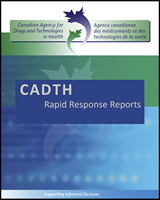There is no cure for lymphedema. The complex decongestive therapy (CDT) is a multimodal therapy, which is recognized as a conservative management of lymphedema and consists of compression therapy (i.e., multilayer bandaging), manual lymphatic drainage (MLD), exercise and skin care. Intermittent pneumatic compression (IPC) can be used in the treatment of lymphedema as an adjunct to CDT, particularly in patients with compromised mobility or physical exercise. Although lymphedema reduces after application, the use of IPC remains controversial due to its adverse effects, including the recurrence of edema due to residual proteins remaining in the interstitial space, and potential lymphatic structure damage due to high pressure application.
The aim of this report is to review the clinical effectiveness and evidence-based guidelines on the use of IPC devices for adult patients with primary and secondary lymphedema in any setting.
About the Series
Rapid Response Report: Summary with Critical Appraisal
Disclaimer: The information in this document is intended to help Canadian health care
decision-makers, health care professionals, health systems leaders, and
policy-makers make well-informed decisions and thereby improve the quality of health
care services. While patients and others may access this document, the document is
made available for informational purposes only and no representations or warranties
are made with respect to its fitness for any particular purpose. The information in
this document should not be used as a substitute for professional medical advice or
as a substitute for the application of clinical judgment in respect of the care of a
particular patient or other professional judgment in any decision-making process.
The Canadian Agency for Drugs and Technologies in Health (CADTH) does not endorse
any information, drugs, therapies, treatments, products, processes, or services.
While care has been taken to ensure that the information prepared by CADTH in this
document is accurate, complete, and up-to-date as at the applicable date the
material was first published by CADTH, CADTH does not make any guarantees to that
effect. CADTH does not guarantee and is not responsible for the quality, currency,
propriety, accuracy, or reasonableness of any statements, information, or
conclusions contained in any third-party materials used in preparing this document.
The views and opinions of third parties published in this document do not
necessarily state or reflect those of CADTH.
CADTH is not responsible for any errors, omissions, injury, loss, or damage arising
from or relating to the use (or misuse) of any information, statements, or
conclusions contained in or implied by the contents of this document or any of the
source materials.
This document may contain links to third-party websites. CADTH does not have control
over the content of such sites. Use of third-party sites is governed by the
third-party website owners’ own terms and conditions set out for such sites.
CADTH does not make any guarantee with respect to any information contained on such
third-party sites and CADTH is not responsible for any injury, loss, or damage
suffered as a result of using such third-party sites. CADTH has no responsibility
for the collection, use, and disclosure of personal information by third-party
sites.
Subject to the aforementioned limitations, the views expressed herein are those of
CADTH and do not necessarily represent the views of Canada’s federal,
provincial, or territorial governments or any third party supplier of
information.
This document is prepared and intended for use in the context of the Canadian health
care system. The use of this document outside of Canada is done so at the
user’s own risk.
This disclaimer and any questions or matters of any nature arising from or relating
to the content or use (or misuse) of this document will be governed by and
interpreted in accordance with the laws of the Province of Ontario and the laws of
Canada applicable therein, and all proceedings shall be subject to the exclusive
jurisdiction of the courts of the Province of Ontario, Canada.

